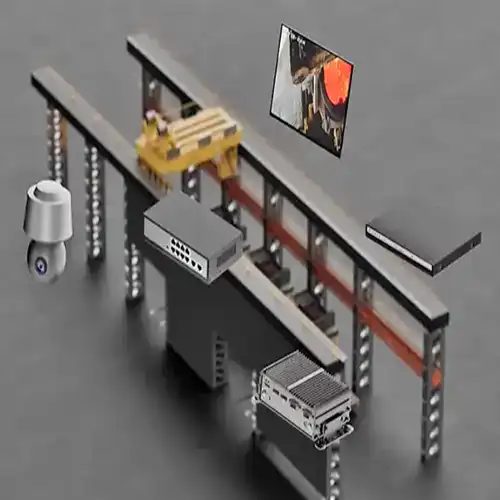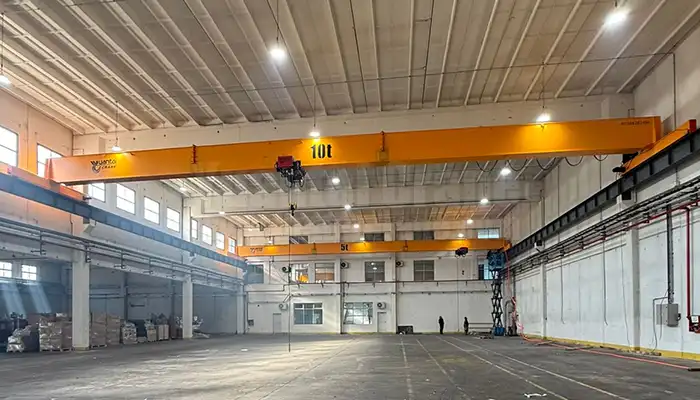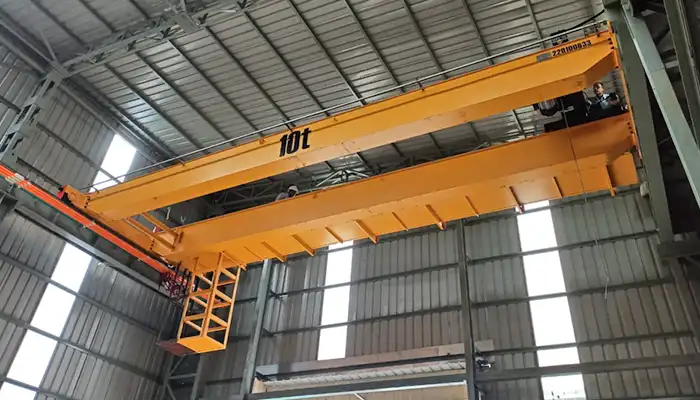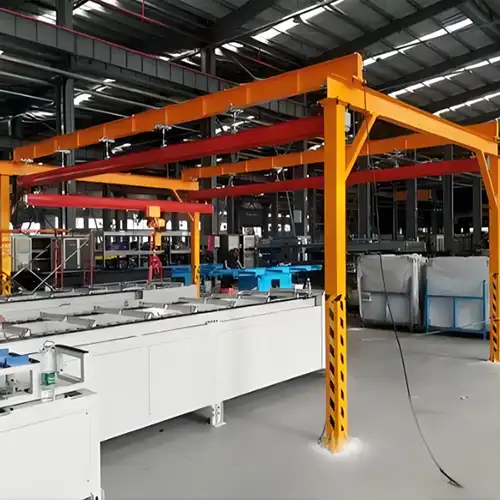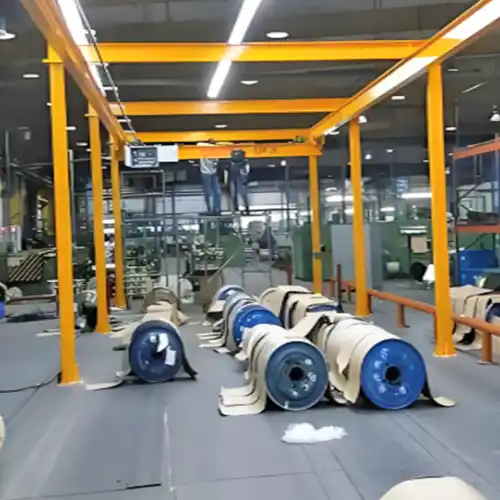Common Compatibility Challenges in EOT Crane Upgrades
Discover typical mechanical, electrical, and software issues in EOT crane upgrades—and practical solutions for smooth, reliable modernization.
Category: Featured
Your Trusted Overhead Eot Crane Manufacturer & Supplier
Common Compatibility Challenges in EOT Crane Upgrades and How to Solve Them
Introduction
Overview of EOT Crane and Overhead Bridge Crane Upgrades
Upgrading an EOT crane or an overhead bridge crane is a common step many industrial facilities take to improve safety, efficiency, and reliability. Overhead travelling cranes are often heavy-duty equipment that operate daily under tough conditions, so keeping them up-to-date is crucial. Whether it's replacing worn-out parts, adding new control systems, or enhancing lifting capacity, crane upgrades can extend the life of your investment and adapt your operation to changing needs.
But it's not just about swapping old parts for new ones. Upgrading an overhead bridge crane means understanding how new components will work with the existing system. Compatibility is key to a smooth upgrade process.
Why Compatibility Matters in Bridge Crane Modernization
Many crane owners and operators underestimate the challenges that come with upgrading. It's tempting to assume that new parts or control systems will just "plug and play" with the existing setup. Unfortunately, that's often not the case.
Here's why compatibility matters:
- Mechanical fit: New components might not align with existing crane structures or mounting points.
- Electrical systems: Voltage, frequency, or wiring differences can cause problems.
- Control integration: Older cranes may use outdated controls that don't communicate well with modern systems.
- Safety and regulations: Upgrades need to meet current safety standards, which might have changed since the crane was first installed.
Ignoring these factors can lead to downtime, increased costs, or even unsafe operations.
What This Article Covers for Overhead Travelling Crane Owners and Operators
This article is designed to help you understand the most common compatibility challenges when upgrading your EOT crane or overhead bridge crane. Whether you're a crane operator, maintenance manager, or plant engineer, you'll find practical advice to:
- Identify typical mechanical and electrical compatibility issues
- Learn about control system integration challenges
- Understand how to plan your upgrade to avoid costly mistakes
- Explore solutions that make your crane upgrade go smoothly
By the end, you should feel more confident approaching your crane upgrade project with the right knowledge and questions in hand.
Common Compatibility Challenges in Overhead Bridge Crane Upgrades
Upgrading an overhead bridge crane or EOT crane isn't as simple as swapping out parts. Many challenges arise because new equipment must fit and work smoothly with what's already installed. Let's break down the most common compatibility issues you'll likely face.
Mechanical Compatibility Issues in Bridge Cranes
Mechanical compatibility is often the first hurdle. Overhead cranes vary widely in their frame sizes, mounting points, and overall structure. This means a new component—whether it's a trolley, hoist, or bridge girder—may not line up perfectly with the existing crane.
- Frame size and mounting points: Older cranes might have different beam widths or mounting hole patterns compared to new parts. If these don't match, you might need custom adapters or even structural modifications.
- Hook height and lifting capacity: When upgrading an EOT crane's lifting mechanism, differences in hook height can affect the maximum lift and the space needed below the crane. It's important to verify that the new hook and hoist will fit your workspace and meet load requirements.
- Structural integrity and load distribution: The crane's bridge and runway beams must be able to handle any changes in load or weight distribution. New equipment that's heavier or lifts differently could stress parts not designed for those forces.
Ignoring these mechanical details can cause serious problems during installation or operation, from misalignment to unsafe loads.
Electrical and Control System Compatibility for Overhead Travelling Cranes
Electrical compatibility is just as critical as mechanical fit. Overhead travelling cranes often operate on specific voltage and frequency standards. Upgrading controls or motors without matching these standards can cause failures or poor performance.
- Voltage and frequency mismatches: Your plant's power supply may be 380V/50Hz, 440V/60Hz, or something else. New motors or drives must match these specs exactly. Otherwise, you risk overheating, poor motor performance, or damage.
- Control panel and wiring standards: Older cranes might use control panels with outdated wiring or different safety protocols. New control units may not fit or work without rewiring or replacing parts of the control system.
- Integration with automation and safety systems: Many modern overhead bridge cranes include automation features, like remote operation or safety interlocks. When upgrading, existing automation may not be compatible with new equipment, requiring protocol converters or software adjustments.
Overlooking electrical compatibility can lead to costly downtime or safety hazards, so it's essential to review all electrical specs carefully before starting.
Upgrading the software and communication systems of an overhead travelling crane is often overlooked, but it's a common source of headaches.
- Different communication protocols: Older EOT cranes may use legacy communication methods that don't talk easily with modern control systems. For example, your existing crane might use a proprietary protocol, while new components support only standard industrial networks like Ethernet/IP or Profibus. Without a proper interface or gateway, the parts simply won't communicate.
- Software version incompatibility: Sometimes the control software installed years ago isn't compatible with the latest hardware upgrades. Newer software often requires updated operating systems or firmware versions, which may not be supported on old control panels. This mismatch can cause system errors or loss of control features.
- Remote monitoring and diagnostics challenges: Many modern bridge cranes offer remote diagnostics and real-time monitoring to improve maintenance and reduce downtime. However, integrating these features into an older crane's system can be tricky if the existing hardware and software don't support data communication standards. It may require additional modules or complete control system replacements.
If your goal is a smarter, more connected overhead crane, planning for these software and communication issues early is a must.
Space constraints are a practical challenge that affects many overhead travelling crane upgrades. Whether your facility is a tight workshop or a busy plant, the physical environment matters a lot.
- Limited workshop or plant space: Sometimes the existing crane runway or workshop ceiling limits what you can install. Larger or heavier new components might not fit without modifying the building or runway beams. This can add unexpected costs and delays.
- Overhead clearance and runway beam compatibility: The height between the runway beam and the floor—or the distance between parallel runway beams—directly impacts what kind of upgrades you can make. If the clearance is low, it may limit hoist size or travel range. Also, new components need to match the dimensions and load ratings of existing runway beams.
- Access for maintenance and parts replacement: Don't forget to consider how easy it will be to service the upgraded crane. If new parts make it harder to reach important components, maintenance downtime can increase. Good access pathways and removable panels should be part of the upgrade plan.
In short, physical space isn't just about fitting parts in — it affects crane performance, safety, and long-term maintenance.
Upgrading an overhead travelling crane isn't just about equipment fit and function — you also have to meet today's safety and regulatory standards. Regulations often change over time, and what was acceptable when your crane was first installed may no longer pass inspection today.
- Updates in safety regulations:
Since your original overhead crane was installed, workplace safety rules may have become stricter. This could include requirements for better emergency stops, updated load indicators, or improved operator controls. Upgraded cranes need to comply with current national and international standards such as OSHA, ANSI, or ISO. Ignoring this can lead to costly fines or forced shutdowns. - Certification challenges for upgraded components:
When replacing or upgrading parts of an EOT crane, you'll often need new certification to prove compliance. This might include third-party inspections, load testing, and documentation of materials used. Sometimes manufacturers provide these certifications, but it's important to verify them before installation to avoid surprises during audits. - Environmental and operational safety requirements:
Besides structural and electrical safety, upgraded overhead bridge cranes may need to meet specific environmental requirements. For example, cranes used in dusty, humid, or explosive environments require special protection and certifications. Noise limits and energy efficiency standards can also come into play, depending on your industry and location.
Addressing these regulatory and safety requirements early in your upgrade plan protects your workers and your business from risks down the road.
Solutions to Compatibility Challenges in EOT Crane Upgrades
Upgrading your EOT crane or overhead bridge crane doesn't have to be a headache. With the right approach, you can tackle compatibility challenges head-on and make sure your crane runs smoothly for years to come. Here are practical solutions to common upgrade problems.
Comprehensive Pre-Upgrade Assessment for Overhead Bridge Cranes
Before you start ordering parts or scheduling installation, take a close look at what you already have. A detailed inspection is key to understanding compatibility issues upfront.
- Inspect the existing crane structure and systems thoroughly: Check the frame, runway beams, hoist, electrical wiring, and control systems. Look for wear, damage, or any unusual modifications.
- Gather accurate technical data and documentation: Make sure you have up-to-date drawings, load charts, electrical schematics, and control manuals. This info helps match new parts properly.
- Involve a multidisciplinary team: Bring together engineers, maintenance staff, operators, and safety experts. Their combined knowledge will catch potential problems you might miss alone.
Doing this groundwork saves time, money, and frustration later.
Use of Modular and Standardized Components for Overhead Cranes
Modular crane components are designed to fit together easily and adapt to different crane setups. Choosing these parts can simplify your upgrade and reduce downtime.
- Modular parts increase upgrade flexibility: You can swap or add components without major structural changes.
- Select components that meet international standards: Look for ISO, CE, or ANSI certifications to ensure quality and compatibility.
- Use flexible design approaches: For example, adjustable brackets or universal mounting kits help new parts fit older cranes without custom fabrication.
Standardization means easier maintenance and better long-term support.
Electrical and Control System Adaptation for Overhead Bridge Cranes
Electrical mismatches are a common stumbling block. Here's how to handle them:
- Use transformers or frequency converters: These devices help match your plant's power supply to the voltage and frequency requirements of new motors or drives.
- Upgrade control systems with compatible interfaces: Modern controls often support multiple protocols, so choose systems that can "talk" to your existing setup or easily adapt.
- Employ protocol converters or middleware: These tools bridge communication between old and new control units, ensuring smooth data exchange and remote monitoring capabilities.
Electrical adaptation is key to avoiding surprises during installation and startup.
Customized Engineering Solutions for Bridge Crane Upgrades
Sometimes off-the-shelf parts won't cut it. Custom engineering can solve unique fit or function challenges.
- Design custom adapters or brackets: If mounting holes don't line up or beam sizes differ, tailored brackets can bridge the gap.
- Tailor software updates or patches: Work with your control system provider to update or modify software to work with new hardware.
- Reinforce structural components if needed: When new equipment adds weight or changes load patterns, strengthening the crane structure keeps everything safe.
Custom solutions require expertise but pay off by ensuring a perfect fit.
Collaboration with Experienced Overhead Crane Manufacturers and Suppliers
Working with the right partners makes a big difference.
- Consult experts early: Experienced manufacturers understand the common pitfalls and can recommend the best upgrade paths.
- Leverage supplier support: Many suppliers offer engineering services, on-site assistance, and integration help.
- Use third-party inspections and certifications: Independent checks confirm your upgraded crane meets all safety and quality standards.
Good collaboration shortens project timelines and boosts confidence.
Planning Installation and Maintenance for Overhead Bridge Cranes
Even the best upgrade can fail without careful planning.
- Schedule upgrades to minimize downtime: Coordinate installation during planned shutdowns or off-peak hours to reduce impact on production.
- Train staff on new systems and safety protocols: Operators and maintenance crews need to understand new controls and procedures.
- Ensure long-term support and spare parts availability: Work with your supplier to secure ongoing service, warranty coverage, and access to replacement parts.
Proper planning keeps your crane running safely and efficiently long after the upgrade.
Case Studies / Examples of Compatibility Challenges and Solutions in EOT Crane Upgrades
Real-world experience often provides the best lessons when it comes to upgrading overhead bridge cranes. Below are some examples illustrating common compatibility challenges and how they were overcome during actual EOT crane modernization projects.
Case Study 1: Mechanical Misalignment in Hoist Replacement
A steel fabrication plant needed to upgrade the hoist on their 10-ton overhead travelling crane. The new hoist had a slightly different mounting pattern and hook height.
- Challenge: The new hoist didn't fit perfectly on the existing trolley, causing alignment and safety concerns.
- Solution: Custom brackets were designed and fabricated to adapt the new hoist mounting holes to the trolley frame. The hook height was adjusted by modifying the trolley suspension to maintain the correct lift range.
- Outcome: The hoist upgrade was completed with minimal downtime and restored safe lifting capacity.
Case Study 2: Electrical Control System Integration
A manufacturing facility replaced an outdated control panel on their 20-ton bridge crane but faced issues connecting the new panel to the original motors and safety sensors.
- Challenge: The control panel used modern communication protocols incompatible with the legacy crane wiring and sensors.
- Solution: Protocol converters and interface modules were installed to bridge old and new systems, allowing seamless communication without rewiring the entire crane.
- Outcome: The control upgrade improved operational safety and enabled remote diagnostics without extensive rewiring.
Lessons Learned from Modernization Projects
- Always conduct a thorough assessment before selecting upgrade components.
- Involve experienced manufacturers early to anticipate hidden challenges.
- Consider modular parts and standardized interfaces to reduce custom work.
- Don't overlook software and communication compatibility—these often cause delays.
- Plan installation timing carefully to avoid disrupting production.
Conclusion
Upgrading an overhead travelling crane or bridge crane comes with its fair share of compatibility challenges. Mechanical differences, electrical mismatches, software conflicts, space constraints, and updated safety regulations can all complicate the process if not addressed early.
That's why thorough planning is crucial. Taking the time to carefully assess your existing crane, gather detailed technical information, and work closely with experienced professionals can save you from costly delays and ensure a smoother upgrade.
Remember, overlooking compatibility issues doesn't just risk installation problems—it can affect the long-term safety and reliability of your overhead crane. For the best results, approach your EOT crane upgrade with a clear plan and the right support. This way, you'll keep your operations running safely and efficiently well into the future.
Related Products
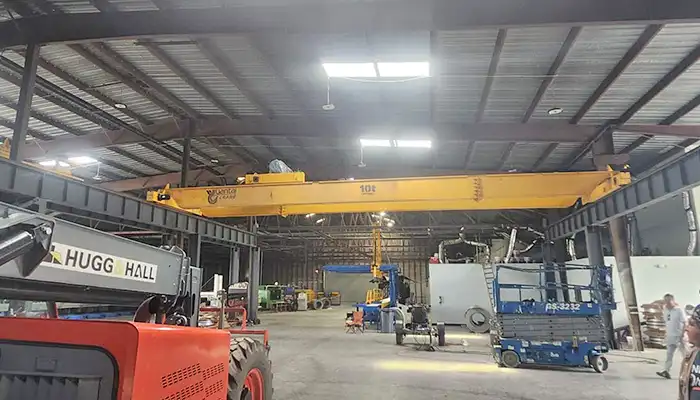
Affordable 10 ton double girder overhead crane with CD/MD hoist trolley, built for U.S. standards, ideal for construction and industrial lifting
Free consultation to Confirm Parameters & Specifications and Get
Latest Crane Price & Crane Rate.
- Types of overhead cranes : _______?
- Optional: Overhead travelling crane, goliath gantry crane,Slewing jib crane, Single girder or double girder crane,small portable crane or kbk crane, etc.
- Capacity of overhead crane: _______?
- Optional: 0.25ton, 0.5 ton, 1 ton, 2 ton, 3ton, 5 ton, 10 ton,15ton, 20ton, 25 ton, 30ton,35ton, up to 550ton, etc.
- Crane span & lifting height : _______?
- Crane travelling length : _____?
- Control of overhead crane:_______?
- Optional: pendant/ remote/cabin control
- Voltage supply of overhead crane:_____?
- Eg,: 380V50/60HZ,3Phase or others,etc.
- Application/usage of crane:_______?
- Eg,: Steel mill, ,injection mold, cement,stone, concrete,granite, general manufacturing, etc.
Just leave a message via the contact form and our hoist and crane engineer will contact you with in 24working hours.
Get In Touch
